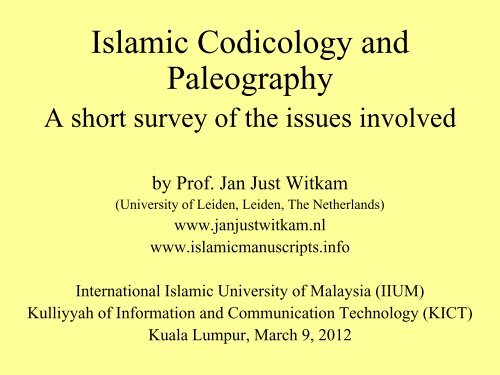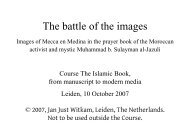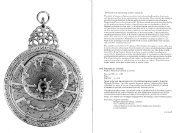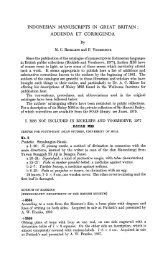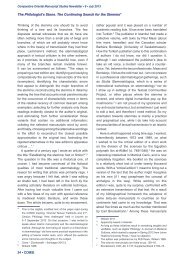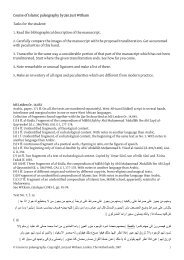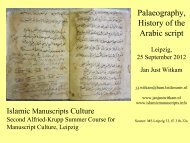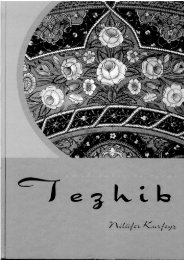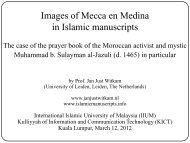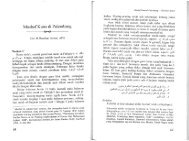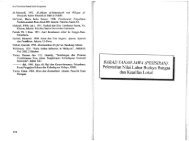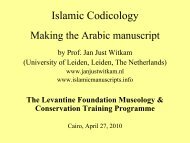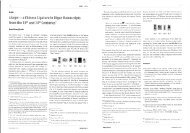Watermarks - Islamic manuscripts
Watermarks - Islamic manuscripts
Watermarks - Islamic manuscripts
Create successful ePaper yourself
Turn your PDF publications into a flip-book with our unique Google optimized e-Paper software.
<strong>Islamic</strong> Codicology and<br />
Paleography<br />
A short survey of the issues involved<br />
by Prof. Jan Just Witkam<br />
(University of Leiden, Leiden, The Netherlands)<br />
www.janjustwitkam.nl<br />
www.islamic<strong>manuscripts</strong>.info<br />
International <strong>Islamic</strong> University of Malaysia (IIUM)<br />
Kulliyyah of Information and Communication Technology (KICT)<br />
Kuala Lumpur, March 9, 2012
Survey of subjects of codicology and paleography:<br />
1. codicology<br />
writing surface: papyrus, parchment, paper, other<br />
quires: organization of the codex<br />
instruments<br />
techniques: ruling, lay-out<br />
craftsmen<br />
2. paleography<br />
scripts: paleography, styles, calligraphy<br />
ornamentation: illumination, illustration<br />
3. various:<br />
bookbinding<br />
dating a manuscript<br />
collections of <strong>manuscripts</strong><br />
terminology in use
The term ‘Codicology’ is derived from the Latin word codex. The<br />
codex is the book as we know it. Novelties of the codex: random<br />
opening, text on the two sides of the writing material. The codex was<br />
invented in Europe in c. 300 CE.<br />
Source: Déroche 2006, p. 16
Before the codex there were already ‘books’. The volumen is such an<br />
earlier book form:<br />
Source: Déroche 2006, p. 13
‘A Reading from Homer’ for an audience of young and beautiful<br />
people, with the use of a parchment scrol, a ‘volumen’.<br />
Classicist painting by Sir Lawrence Alma Tadema (1838-1912) of<br />
a reading session, as imagined by the painter in 1885.<br />
Source: Original painting, oil on canvas, 91.8 x 183.5 cm, in Philadelphia Museum of Art.
Before the codex there were already ‘books’. The rotulus is yet<br />
another earlier book form. This form has been preserved in Islam for<br />
non-official texts, such as genealogies, diploma, talismans, etc.<br />
Source: Déroche 2006, p. 13
Outside the Mediterranean world entirely different shapes of the book<br />
were devised. Here is a Sanskrit text on palmleaf. This shape of the<br />
book has been preserved in South-East Asia as well.<br />
Source: Déroche 2006, p. 16
Leather (kulit) is used in<br />
South-East Asia also as<br />
writing material.<br />
Here it is the writing material<br />
on which a set of Silsila’s<br />
from Malaysia has been<br />
written.<br />
The heading reads: Silsila raja<br />
Patani keturunan Kelantan<br />
ilah Teungku Muhammad<br />
teungku besar raja Patani.<br />
Source: MS Leiden Or. 26.541, ff. 40b-41a
Wood can also be used as writing material.<br />
Documents from an archive of a public notary, from the High<br />
Atlas Area in Central Morocco. Source: UB Leiden, Or. 26.165
:(البردي) Papyrus<br />
The word is used for the plant<br />
and also for the writing material<br />
made of that plant.<br />
The plant is typically Egyptian,<br />
but not exclusively so. It is<br />
known to grow in other regions<br />
where there is an abundance of<br />
water, such as Mesopotamia.<br />
The etymology of the word<br />
‘papyrus’ is Coptic. From it, the<br />
word ‘paper’ in European<br />
languages was derived, through<br />
Greek and Latin, but paper and<br />
papyrus are entirely different<br />
materials.<br />
Source image: Jonathan Bloom, Paper before<br />
print, (2001) No.20.
Qalam or Qasab (reed, sugar<br />
reed) and Papyrus (Fafirus, al-<br />
Bardi), as depicted in the Arabic<br />
translation of the Materia Medica<br />
of Dioscurides (c. 40-90 CE), in a<br />
manuscript written in Samarqand<br />
in 475/1082.<br />
It is a coincidence that the two<br />
base materials for writing, the pen<br />
and the leaf, are here depicted on<br />
one and the same page.<br />
See also the medical use of the<br />
papyrus plant: the care for the<br />
wounds made during treatment of<br />
hemorrhoids and fistulae.<br />
Source: MS Leiden, Or. 289, f. 35a
A bilingual (Greek and Arabic) text (a document of financial content) on<br />
papyrus. This is possibly the oldest dated Arabic text on papyrus: Gumada<br />
I of the year 22 Higra (643 CE).<br />
Source: Vienna, National Library.
Parchment, showing which part of the hide can be used for writing.<br />
Folding twice gives a standing or oblong format, folding three times<br />
gives an almost square format (as books from the Maghreb have).<br />
Source: drawing from F. Déroche (2006), p. 39
Large (c. 50 x 70 cm) Qur’an on parchment, showing hairside (left)<br />
and fleshside (right). Note the difference in colour. The two leaves<br />
shown do not belong together, text is not continuous. The parchment<br />
has become brittle (dried out) and was damaged in course of time.<br />
Source: MS Leiden Or. 14.545a, ff. 1b-2a
Qur’an 8:1-13.<br />
The first line reads:<br />
الله ورسوله ان كنتم مومنين، انما<br />
المومنون الذين<br />
One of the oldest known<br />
Qur’anic <strong>manuscripts</strong>,<br />
possibly datable to the end of<br />
the first century Hijra<br />
(beginning 8th century CE).<br />
The writing material is<br />
parchment, the backward<br />
leaning (ma’il) script is called<br />
Hijazi. It is entirely without<br />
punctuation and without<br />
vowels.<br />
Source: MS Paris, BnF, Arabe 328a, f. 40a
A Maghribi (or Andalusi?) Qur’an on parchment, showing<br />
traces of scraping (bottom, left), 13th century (?).<br />
Source: MS Leiden Or. 228, p. 27, detail.
A Maghribi (or<br />
Andalusi?) Qur’an<br />
on parchment.<br />
Colours indicate<br />
additions to the<br />
`Uthmani rasm. Not<br />
dated but possibly of<br />
the 13th century. In<br />
the West of the<br />
<strong>Islamic</strong> world,<br />
parchment remained<br />
longer in use (for<br />
important texts) than<br />
in the Mashriq.<br />
Source: MS Leiden Or. 251, f.<br />
24a
Paper, a Chinese invention, conquers the world<br />
A short chronology:<br />
Oldest paper known in China, where the technique of paper making<br />
was invented; it dates from the beginning of the Christian era, or<br />
before.<br />
Imports of Chinese paper in the Middle East before the 8th century<br />
are known, but not documented.<br />
Beginning of <strong>Islamic</strong> papermaking in Central-Asia, mid-8th century.<br />
Slow but irresistible journey of paper in Western direction. Around<br />
year 1000 complete substitution of parchment and papyrus by paper<br />
in Mashriq. The Maghrib follows suit.<br />
Around the year 1500 is the end of Middle-Eastern paper industry<br />
due to heavy competition from Europe, especially Italy. Remote<br />
regions (e.g. Central-Asia) keep producing their own paper.
Fictitious<br />
portrait of Tsai<br />
Lun, the Chinese<br />
minister said to<br />
be the inventor<br />
of paper making<br />
in the year 105<br />
CE.<br />
He has his<br />
writing utensils<br />
in front of him<br />
on the table.<br />
Source: woodcut<br />
reproduced in Voorn,<br />
Papiermolens Noord-<br />
Holland, plate 1.
Chinese paper makers at work. Filling the mould with paper pulp (left),<br />
and emptying the mould by piling-up the ready paper leaves (right).<br />
Source: A. Grohmann, Arabische Paläographie, vol. 1, p. 103, after Joseph von Karabacek..
:(ورق، قرطاس، كاغذ) Paper<br />
Different etymologies of the word<br />
for paper: waraq is Arabic, qirtas<br />
comes from Latin, kaghidh is a<br />
Soghdian (Central-Asia) loanword.<br />
In English ‘paper’ is derived from<br />
the ‘papyrus’.<br />
The image shows a female paper<br />
maker from Nepal, using a simple<br />
mould over which paper pulp is<br />
poured. When the water has leaked<br />
away, the solid material is paper of<br />
blotting quality.<br />
After drying under pressure the<br />
surface of the paper has to be<br />
covered or polished in order to<br />
prevent ink from leaking through.<br />
Source image: Jonathan Bloom, Paper before print,<br />
(2001) p. 67.
A Japanese paper mould, as still in use.<br />
Chinese, and therefore Japanese, culture is still very much<br />
characterized by a great veneration of paper, and paper making is,<br />
apart from an industry, often also a hobby and pastime.<br />
Source image: Jonathan Bloom, Paper before print, (2001) p. 70.
A papermaker at work:<br />
1. Pulp is made in watermill.<br />
2. Pulp is sieved over water.<br />
3. Basin with watery pulp<br />
4. Mould is filled with pulp<br />
5. Filled mould leaks dry.<br />
6. Sheets dry on a line.<br />
7. Pile of sheets under pressure<br />
8. Paper is sized and polished<br />
Captions are in Persian,<br />
illustration from a Kashmiri<br />
manuscript illustrating arts and<br />
crafts (written c. 1850-1860).<br />
Lower right corner: the well with<br />
the windlass.<br />
Source: Original MS: India Office Library,<br />
London, Or. 1699, here quoted from G. Bosch<br />
(a.o.), <strong>Islamic</strong> bindings. Chicago 1981, p. 21,<br />
explanation on p. 28.
The paper burnisher at work. Source: Original MS: Freer Gallery of Art, N. 54.116.<br />
Washington DC, here quoted from G. Bosch (a.o.), <strong>Islamic</strong> bindings. Chicago 1981, p. 36.
Structure of Oriental paper with chain-lines spaced at regular<br />
intervals. Source: F. Déroche, <strong>Islamic</strong> Codicology (2006), p. 55
Structure of Oriental paper with chain-lines in groups of three.<br />
Source: F. Déroche, <strong>Islamic</strong> Codicology (2006), p. 56
A (Hebrew) manuscript on Oriental paper, dated 1112 CE.<br />
Laid paper with a structure with chain-lines and wire-lines.<br />
Source: Oxford (Bodleian Library), Hebr. F. 18, f. 17, detail; illustration taken from M. Beit-<br />
Arié, Hebrew Codicology (Jerusalem 1981), plate 3.
Gharib al-Hadith, by Abu<br />
‘Ubayd al-Qasim b. Sallam al-<br />
Baghdadi (d. 223/837).<br />
Dated Dhu al-Qa‘da 252 AH (=<br />
866 CE), and thereby probably<br />
the oldest dated Arabic<br />
manuscript on paper in<br />
existence.<br />
The paper is coloured, is very<br />
thick, almost like carton board,<br />
and shows no internal structure<br />
of lines.<br />
The text is written in a<br />
conciously executed lay-out.<br />
Source: MS Leiden, Or. 298, f. 2b
Colophon, dated Dhu al-Qa‘da 252 (= 866 A). Gharib al-Hadith by Abu<br />
‘Ubayd al-Qasim b. Salam. On paper. Edgy script, dots, vowels, reading<br />
signs, all developed.<br />
Source: MS Leiden, Or. 298, f. 241b
Mishkat al-Anwar by Abu Hamid<br />
Muhammad al-Ghazzali (d.<br />
505/1111). Naskh script in several<br />
sizes. Dated 630 AH.<br />
Safina-shaped, note-book. The text<br />
also goes around main text block,<br />
and indicates the limits of the writing<br />
area.<br />
Source: MS Leiden Or. 1093-ff. 1b, beginning of f. 2a.
The advantages of paper over parchment and papyrus<br />
Paper was less cheap than papyrus (more work to manufacture!), but<br />
was more stable. At the same time it was less stable than parchment,<br />
but much cheaper. The combined advantages of parchment and<br />
papyrus made paper the ideal substitute of either one of then.<br />
<strong>Islamic</strong> and Middle Eastern <strong>manuscripts</strong> as we mostly know them are<br />
books made of paper. Papyrus and parchment became obsolete after<br />
the introduction of paper.<br />
The impact of paper on the development of written culture can hardly<br />
be overestimated. The general availability of a relatively cheap<br />
medium gave rise to scholarly multiplicity. Numerous copies of one<br />
and same text were made by many students and teachers. Many new<br />
texts were created and gained right of dissemination. The limitations<br />
of papyrus (fragility) and of parchment (dearth, scarcity) disappeared.<br />
No wonder therefore that the 9th and 10th centuries saw an<br />
unprecedented flowering of sciences and literature in the Middle-East.<br />
Also bureaucracy profited from the wide availability of paper. The<br />
invention of printing is inconceivable without paper.
A Dutch paper mill at work. The<br />
windmill (in Holland) provides<br />
the power needed for the making<br />
of the pulp (central part). At the<br />
left side, moulds are filled with<br />
pulp. At the right side sheets of<br />
paper are drying.<br />
A windmill is used because there<br />
is hardly any running water in<br />
Holland. In mountainous areas<br />
mills obtain their power from<br />
water.<br />
Source: Voorn, Papiermolens Noord-Holland,<br />
plate 7.
Detail of a metal paper mould from<br />
a Dutch paper mill; chain and wire<br />
lines are of metal. The watermark<br />
(shield, crown, post horn) is<br />
attached to the structure of the<br />
mould. At that place the paper will<br />
contain less pulp and hence show<br />
the watermark.<br />
Source: Voorn, Papiermolens van Noord-<br />
Holland, plate 51
<strong>Islamic</strong> watermarks in European<br />
paper.<br />
European papermakers quickly<br />
realized that it was of no use to<br />
export paper with watermarks of<br />
typically Christian or Western<br />
symbols (crosses, crowns and the<br />
like) to <strong>Islamic</strong> countries. They<br />
therefore started to devise<br />
‘<strong>Islamic</strong>’ watermarks. The<br />
crescent was often used. A very<br />
common ‘<strong>Islamic</strong>’ watermark was<br />
a combination of three crescents<br />
in decreasing size. This was<br />
called by its Italian name ‘trelune’<br />
= ‘three moons’.<br />
Source: Heawood, <strong>Watermarks</strong>, plate 136.
<strong>Islamic</strong> watermarks in European<br />
paper.<br />
Several trelune watermarks in<br />
Italian papers used for <strong>manuscripts</strong><br />
found in the Balkans.<br />
Photographing watermarks can be<br />
complicated, and the photographs<br />
are never very clear. That is why the<br />
common reference works on<br />
watermarks (Briquet, Heawood,<br />
Voorn, etc.) prefer to use drawings<br />
of watermarks.<br />
Source: Velkov & Andreev, Tri luni (1983)<br />
Nos. 840-842.
<strong>Watermarks</strong> and dating<br />
The utility of watermarks in dating a manuscript is often overrated.<br />
At best a watermark can corroborate or refute a proposed dating.<br />
Sometimes it can provide an approximate date.<br />
However, if a very popular watermark, such as the trelune or the<br />
anchor, is used, it is virtually impossible to establish a secure dating.<br />
The reason for this is that one can never make an absolute, one-toone,<br />
identification between a watermark in a manuscript or document<br />
and the drawing or photograph of a similar watermark in the<br />
reference works on watermarks.<br />
The illustrations in the reference works on watermarks provide us<br />
with an overview of trends in watermark design and of the periods<br />
and the places in which these were used. From the 19th century<br />
onwards the number of papers with watermarks becomes too large<br />
for any meaningful determination or identification.
A library in the City of<br />
Helwan.<br />
Abu Zayd astonishes his<br />
audience by his wide<br />
knowledge. A scene from<br />
Maqama 2 of the Maqamat.<br />
by al-Hariri (1054-1122).<br />
Against the back are<br />
bookshelves, with books in<br />
different ways of<br />
arrangement.<br />
Painting by Yahya al-Wasiti,<br />
dated 1237 CE, possibly<br />
from Baghdad.<br />
Source: MS Paris, BnF, Arabe 5847, f. 5b.
Scholarship with books and<br />
instruments.<br />
The research team of fifteen<br />
science-minded men of Taqi al-Din<br />
b. Ma‘ruf, the famous late-16thcentury<br />
astronomer to the Ottoman<br />
Sultan, in his newly established<br />
Observatory in Istanbul.<br />
Classical <strong>Islamic</strong> instruments and<br />
modern Western equipment can be<br />
seen together in one image.<br />
At the background are bookshelves,<br />
with the Observatory’s library. The<br />
captions are given in Persian poetry.<br />
Source: MS Istanbul, University Library.
Illuminated title-page of<br />
Shawarid al-Amthal.<br />
Anonymous collection of<br />
proverbs. With illuminated<br />
ex-libris of the library of an<br />
Ayyubid prince (12th<br />
century CE). Text of the<br />
ex-libris:<br />
| شوارد الامثال بخزانه<br />
مولانا السلطان الملك الناصر<br />
صلاح الدنيا والدين ابى<br />
المظفر يوسف ابن الملك<br />
العزيز خلد الله ملكه ه<br />
|<br />
|<br />
|<br />
Source: MS Leiden, Or. 1073, f. 1a<br />
|<br />
|<br />
|
Complexities: Not all <strong>manuscripts</strong> of the Middle East are always in<br />
Arabic script, even if their language is Arabic. Example: Qissat Yusuf<br />
ha-Saddiq, in Judeo-Arabic, copied in Mosul, 1859<br />
Source: MS Leiden Or. 14.403, ff. 16b-17a
Complexities: Not all<br />
<strong>manuscripts</strong> of the Middle<br />
East are exclusively in Arabic<br />
script, even if their language<br />
is sometimes Arabic.<br />
Example: Christian prayer for<br />
after the noon meal. Greek<br />
and Arabic text. Egypt,<br />
possibly 13th century.<br />
Bilingual texts are often in<br />
use when the older of the two<br />
languages has become less<br />
well-known.<br />
Source: MS Leiden Or. 14.239, f. 38a
Complexities: Not all<br />
<strong>Islamic</strong> <strong>manuscripts</strong> are<br />
always entirely in Arabic<br />
script.<br />
Example: A Qur’an from<br />
Sulawesi (Indonesia) with<br />
Makassarese interlinear<br />
translation, copied<br />
between 1861-1869.<br />
Source: MS Leiden, NBG Boeg. 52e,<br />
p. 183
Complexities: Not all<br />
<strong>manuscripts</strong> of the Middle<br />
East are always entirely in<br />
Arabic script and in the<br />
Arabic language.<br />
Example: Beginning of Sifr<br />
Ayyub al-Barr, the Book Job,<br />
of the Old Testament, in<br />
Coptic and Arabic. Dated<br />
1508/1792<br />
Source: MS Leiden, Or. 14.544, f. 4a
Not all <strong>manuscripts</strong> of the<br />
Middle East are always in<br />
Arabic script, even if the<br />
language is Arabic.<br />
The first line reads<br />
(transcribed in Arabic):<br />
بسم الاب والابن وروح القدس<br />
It is the Christian basmala.<br />
Example: Khitam fi Alhan<br />
al-Mar Afram, by al-Khuri<br />
al-Salibi al-Dimashqi.<br />
Arabic text in Syriac script:<br />
Karshuni. Dated (possibly)<br />
Rome, 18th century.<br />
Source: MS Leiden, Or. 14.607, f. 139b.
Complexities: Not all <strong>Islamic</strong><br />
<strong>manuscripts</strong> are always in<br />
Arabic, though written in<br />
Arabic script. Example:<br />
Fragment of an old (15thcentury<br />
CE?) text in Berber.<br />
This extremely rare (just this<br />
damaged leaf preserved!)<br />
example of a work written in<br />
Berber proves that already in<br />
the Middle Ages there was a<br />
written Berber culture. There<br />
are several words<br />
recognizable in Arabic, but<br />
the overall text is in Berber.<br />
Source: MS Leiden Or. 23.306, recto side
Complexities: Not all <strong>Islamic</strong><br />
<strong>manuscripts</strong> are always in<br />
Arabic script.<br />
Example: Miniature of the Ark<br />
of the Prophet Nuh, in a<br />
Javanese translation of an<br />
Arabic or Persian version of<br />
the Qisas al-Anbiyâ’, the<br />
‘History of the Prophets’.<br />
Manuscript in Javanese, from<br />
Java (Indonesia), around 1830.<br />
Look at the Dutch flag, with<br />
the words Lâ and Allâh<br />
written in it, apparently as part<br />
of the Shahâda.<br />
Source: MS Leiden Or. 2251, p. 22
Drawing of the human organ of speech: a cross-section of the mouth.<br />
Indicated are the articulation points of the Arabic phonemes, as part of<br />
the preliminary pages of an Acehnese Qur’ân of the 19th century. In<br />
non-arabophone regions (Turkey, South-East Asia, etc.) one may find<br />
similar explanations of Arabic phonology. On the left side a poem in<br />
Malay telling how to recite the Qur’an. Source: MS Leiden, Or. 2064, f. 4a
A ceramic inkwell from Morocco (19th/20th century) for<br />
the making of polychrome <strong>manuscripts</strong>.<br />
Source: Original in collection J.J. Witkam, Leiden.
Another ceramic inkwell, with silver frame (not original?),<br />
and provided with a Maghribi reed pen, from Morocco<br />
(19th/20th century) for the making of polychrome<br />
<strong>manuscripts</strong>.<br />
Source: Original in collection J.J. Witkam, Leiden
Inkwells from Central-Asia for making monochrome <strong>manuscripts</strong>.<br />
Source: Originals in collection J.J. Witkam, Leiden.
Inkwell from Central-Asia for making monochrome<br />
<strong>manuscripts</strong>, with pen rest. Source: Originals in collection J.J. Witkam, Leiden.
Inkwells for making <strong>manuscripts</strong> in two colours.<br />
Source: Originals in collection J.J. Witkam, Leiden.
Portable penholder with inkwell, for making <strong>manuscripts</strong> in two<br />
colours. Ottoman style after originally Japanese design. This one<br />
was purchased in Surabaya in 1995.<br />
Source: Collection J.J. Witkam, Leiden.
Bambu pens.<br />
Source: Originals in collection J.J. Witkam, Leiden.
Reed pens, Middle-East.<br />
Source: Originals in collection J.J. Witkam, Leiden.
Mistara, ruler with fixed lay-out, and line-applier of bone<br />
(from Egypt)<br />
Source: Originals in collection J.J. Witkam, Leiden
A mistara from South Arabia, with a page<br />
lay-out in columns.<br />
Source: Original in Israel Museum, Jerusalem, image quoted<br />
from Beit-Arié, Hebrew Codicology, plate 17.
A simple student’s<br />
mistara from the Cairo<br />
genizah.<br />
Source: Original in Cambridge<br />
University Library, TS K 11.54, image<br />
quoted from Beit-Arié, Hebrew<br />
Codicology, plate 19.
A simple student’s mistara from<br />
Egypt. The threads are pasted to<br />
the cardboards. The reverse side<br />
of the cartdboard has the exact<br />
mirror image of this page. The<br />
present side makes a recto page<br />
in an Arabic manuscript, the<br />
reverse the exactly identical<br />
verso page. Age not determined,<br />
but possible beginning 20th<br />
century. Height c. 29 cm.<br />
Source: Original in the Library of Deir al-Anba<br />
Maqar, the Monastry of St. Macarius, Wadi<br />
Natrun (Egypt). This mistara was shown during<br />
the course by Father Epiphanius El-Makari, one<br />
of the participants.
Paper scissors (Egypt, 16th century CE?), with detail:<br />
.(يا فتاح) Ya Fattah<br />
Source: Originals in collection J.J. Witkam, Leiden.
The components and proportions of the Arabic script, here shown for<br />
a type font, but they can equally be used for a better under-standing of<br />
the Arabic script. Don’t forget: Type designers are calligraphers.<br />
Useful terminology for describing the constituent elements of script.<br />
Source: Edo Smitshuijzen, Arabic Font Specimen Book. Amsterdam 2009, p. 19.
Most decipherment is given<br />
by the text itself<br />
The formulaic character of<br />
some texts, not only of<br />
documents but of numerous<br />
non-literary texts, helps to solve<br />
previously unsolved reading<br />
problems.<br />
This is particularly the case<br />
with theological literature,<br />
where a limited vocabulary is<br />
repetitively used. The reading<br />
certificates at the end of texts or<br />
quires are another case in point.<br />
Source: MS Leiden, Or. 580, f. 11b.
|<br />
وفى اخره ما مثاله سمع جميع هذا الجز على الشيخ ابى محمد عبد الكريم<br />
بن حمزه بن الخضر بن العباس السلمى رضى الله عنه قال ىا عبد الحميد بن<br />
احمد بن محمد الكتانى فى سنه ثمان وخمسين واربعمايه صاحبه الشيخ ابو<br />
عبدالله الحسين بن الخضر بن الحسين بن عبدان وابنه ابو الحسين عبد<br />
الرحمن بقراه الشيخ ابى القسم على بن<br />
...<br />
|<br />
An example of repetitive text: the titles and proper names in a<br />
reading certificate at the end a quire are another case in point.<br />
Source: MS Leiden, Or. 580, f. 11b, detail of previously displayed page
(إهمال) About ihmāl<br />
The twenty-eight letters of the Arabic alphabet in fact consist of only<br />
some fourteen different groups of base forms.<br />
The letters in each composite group are usually distinguished from<br />
those in the same group by dots or no dots. Those dots are written on<br />
top or underneath the ductus (rasm in Arabic). Writing such dots is<br />
called iʿǧām, ʻto provide with a diacritical pointʼ. Not writing such dots<br />
is called ihmāl, ʻto neglectʼ, ʻto omitʼ, ʻnot-providing with dotsʼ.<br />
The following fourteen groups of base forms are distinguished in the<br />
Arabic alphabet: 1. alif; 2. bāʾ, tāʾ, thāʾ, nūn, yāʾ; 3. ǧīm, ḥāʾ, khāʾ; 4.<br />
dāl, dhāl; 5. rāʾ, zāy; 6. sīn, shīn; 7. ṣād, ḍād; 8. ṭāʾ, ẓāʾ; 9. ʿayn, ghayn;<br />
10. fāʾ, qāf; 11. kāf, lām; 12. mīm; 13. wāw; 14. hāʾ.<br />
Each copyist has his own choices for providing the muhmalāt with<br />
ihmāl signs. The alif, mīm, wāw and hāʾ are not really groupes and do<br />
not need ihmāl signs. A copyist will not always use all possibilities.
Examples of ihmāl signs:<br />
v-sign on top of ra’, v-sign on top<br />
of sin, little ‘ayn underneath the<br />
‘ayn, little ha’ underneath the ha’,<br />
all in order the indicate that these<br />
letters are neglected.<br />
But note that the emphatic ta’ does<br />
not have a sign of ihmāl.<br />
It is important that the student,<br />
while describing a scribe’s hand,<br />
makes an inventory of the copyist’s<br />
repertoire of ihmāl signs, because<br />
these are meaningful additions.<br />
From a manuscript from Ghazna<br />
(Afghanistan) of the early 11th<br />
century CE.<br />
Source: MS Leiden, Or. 437, p. 2
Kashf al-Asrār ʿan ʿIlm<br />
Ḥurūf al-Ghubār by ʿAlī b.<br />
Muḥammad b. ʿAlī al-<br />
Qurashī, known as al-<br />
Qalaṣādī al-Basṭī (d.<br />
891/1486), dated 1265-<br />
1266 (1849-1850),<br />
Extraordinary polychrome<br />
Maghribi calligraphy.<br />
Source: Collection, J.J. Witkam, Leiden,<br />
No. 35, beginning, f. 210b
Sharḥ al-Farāʾiḍ al-Sirāǧiyya,<br />
commentary by ʿAlī b. Muḥammad<br />
al-Ǧurǧānī al-Sayyid al-Sharīf (d.<br />
816/1413), on Al-Farāʾiḍ al-<br />
Sirāǧiyya, the work on the law of<br />
succession by Sirāǧ al-Dīn<br />
Muḥammad b. Muḥammad b. ʿAbd<br />
al-Rashīd al-Saǧāwandī (lived c.<br />
600/1203).<br />
Central Asian nasta‘liq script, dated<br />
1275 (1858).<br />
Source: Collection, J.J. Witkam, Leiden, No. 60, f.<br />
[4]b, beginning of the text. Purchased in Bukhara,<br />
2009.
Kitāb Dāniyāl al-Nabī lil-<br />
Shuhūr al-Ithnaʿashar wa-<br />
Dukhūl al-Sana. A work on<br />
astronomical phenomena (in<br />
connection with the twelve<br />
months in the solar year, which<br />
are referred to by the Byzantine<br />
names), ascribed to the Prophet<br />
Daniel. Originally a Christian-<br />
Arabic text, but this version is<br />
islamicized (see the basmala)<br />
Ruq‘a script, dated 1271 AH<br />
(1854-1855).<br />
Source: MS Leiden, Or. 12.050, p. 4.
Ta ṣliya prayer. Mention of ʿAbd al-<br />
Qādir al-Ǧīlānī. A manuscript from<br />
The Gambia.<br />
West-African script, end-19th<br />
century, sometimes written as<br />
heard, not according to the rules of<br />
orthography.<br />
Source: Collection J.J. Witkam, Leiden, ff. 1a.
West-African <strong>manuscripts</strong> are<br />
usually written on single leaves or<br />
on sheets, but these are not made<br />
into quires.<br />
These leaves and sheets are put<br />
onto a pile, and then kept in a<br />
satchel.<br />
Source: MS Leiden Or. 14.052 (7)<br />
A typical<br />
sub-Saharan<br />
book satchel.<br />
MS. Leiden<br />
Or. 25.418
Syair Ken Tambuhan. Malay<br />
poetical text. Not dated, but first<br />
half 19th century.<br />
Lay-out from South-East Asia.<br />
Illuminated opening page. Script<br />
possibly derived from Nasta‘aliq<br />
style.<br />
Source: MS Leiden Or. 1965. f. 1b.
Illuminated Qur’an, from South-East Asia, not<br />
dated, but 19th century, assumed so because of<br />
provenance history as it was once owned by the<br />
Dutch orientalist Taco Roorda (d. 1874).<br />
Naskh script for text. Elongated script used for<br />
the headings. Beginning of sura 18 (al-Kahf),<br />
whereby the illumination serves to indicate that<br />
the reader is halfway the text. Right half of an<br />
illuminated double page.<br />
Source: MS Leiden Or. 2098. f. 140b.
The bookbinder at work. A<br />
survey of the tools of the<br />
bookbinder.<br />
Captions are in Persian,<br />
illustration from a Kashmiri<br />
manuscript illustrating arts and<br />
crafts (written c. 1850-1860).<br />
Source: Original MS: India Office Library,<br />
London, Or. 1699, here quoted from G. Bosch<br />
(a.o.), <strong>Islamic</strong> bindings. Chicago 1981, p. 22.
The bookbinder at work.<br />
North India, 17th or 18th<br />
century.<br />
Source: Original in India Office<br />
Library, Add. 1111. Quoted from<br />
G. Bosch (a.o.), <strong>Islamic</strong> bindings.<br />
Chicago 1981, opposite p. 41.
The <strong>Islamic</strong><br />
bookbinding<br />
and its<br />
constituent<br />
parts, with<br />
terminology in<br />
English.<br />
Source: G. Bosch<br />
(a.o.), <strong>Islamic</strong><br />
bindings. Chicago<br />
1981, p. 38.
The study of the (geometrical)<br />
designs in <strong>Islamic</strong> book bindings<br />
is usually classified as part of art<br />
history. In order to have good<br />
reproductions of book bindings<br />
rubbings are used, in preference<br />
to photographs.<br />
Here a rubbing (made by Max<br />
Weisweiler) of the binding around<br />
a MS of Gawidan-i Khirad (al-<br />
Hikma al-Khalida) by Ibn<br />
Miskawayhi (d. 421/1030), dated<br />
729/1329, is shown. One should<br />
always take into account that the<br />
binding shown is later than the<br />
manuscript to which it serves as a<br />
cover.<br />
Source: MS Leiden, Or. 640 (MS dated<br />
729/1329).
One of the best-known<br />
authorities on <strong>Islamic</strong><br />
book bindings is Max<br />
Weisweiler (d. 1968). In<br />
his detailed study Der<br />
islamische Bucheinband<br />
des Mittelalters nach<br />
Handschriften aus<br />
deutschen,<br />
holländischen und<br />
türkischen Bibliotheken<br />
(Wiesbaden 1962), he<br />
showed a great number<br />
of rubbings.<br />
However, in his private collection of study materials he has many more<br />
rubbings and notes on <strong>Islamic</strong> bindings. A page from his study notes is<br />
shown here. Source: Weisweiler Archive. Leiden University Library, Or. 22.307.


